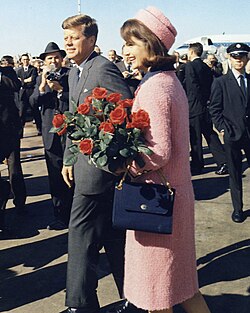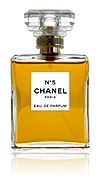
Chanel S.A. is a French privately held company owned by Alain Wertheimer and Gérard Wertheimer, grandsons of Pierre Wertheimer, who was an early business partner of the couturière Coco Chanel. Chanel S.A. is a high fashion house that specializes in haute couture and ready-to-wear clothes, luxury goods, and fashion accessories. In her youth, Gabrielle Chanel gained the nickname Coco from her time as a chanteuse. As a fashion designer, Coco Chanel catered to women's taste for elegance in dress, with blouses and suits, trousers and dresses, and jewellery of simple design, that replaced the opulent, over-designed, and constrictive clothes and accessories of 19th-century fashion. The Chanel product brands have been personified by fashion models and actresses, including Inès de La Fressange, Catherine Deneuve, Carole Bouquet, Vanessa Paradis, Nicole Kidman, Anna Mouglalis, Audrey Tautou, Keira Knightley, Kristen Stewart and Marilyn Monroe.
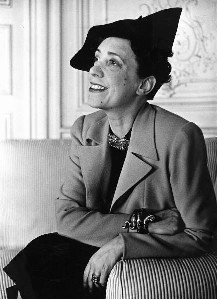
Elsa Schiaparelli was an Italian fashion designer. Along with Coco Chanel, her greatest rival, she is regarded as one of the most prominent figures in fashion between the two World Wars. Starting with knitwear, Schiaparelli's designs were heavily influenced by Surrealists like her collaborators Salvador Dalí and Jean Cocteau. Her clients included the heiress Daisy Fellowes and actress Mae West. Schiaparelli did not adapt to the changes in fashion following World War II and her couture house closed in 1954.

Oleg Cassini was an American fashion designer born to an aristocratic Russian family with maternal Italian ancestry. He came to the United States as a young man after starting as a designer in Rome, and quickly got work with Paramount Pictures. Cassini established his reputation by designing for films.
Lillian Pulitzer Rousseau, better known as Lilly Pulitzer, was an American socialite and fashion designer. She founded Lilly Pulitzer, Inc., which produces clothing and other such wares featuring bright, colorful, floral prints. As the brand is popular with high society, she was called the "Queen of Prep".
Linda Morand is an American fashion model, cover-girl and haute couture mannequin during the 1960s and 1970s. She appeared in national ads, magazine covers, TV commercials and national catalogs. She is currently a fashion archivist and consultant.
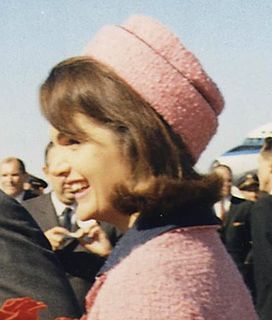
A pillbox hat is a small hat, usually worn by women, with a flat crown, straight, upright sides, and no brim. It is named after the small cylindrical or hexagonal cases that pills used to be sold in.
Born in the second half of the 1970s and developed in the 1980s, power dressing is a fashion style that enables women to establish their authority in a professional and political environment traditionally dominated by men.

Gabrielle Bonheur "Coco" Chanel was a French fashion designer and business woman. The founder and namesake of the Chanel brand, she was credited in the post-World War I era with liberating women from the constraints of the "corseted silhouette" and popularizing a sporty, casual chic as the feminine standard of style. A prolific fashion creator, Chanel extended her influence beyond couture clothing, realizing her design aesthetic in jewellery, handbags, and fragrance. Her signature scent, Chanel No. 5, has become an iconic product. She is the only fashion designer listed on Time magazine's list of the 100 most influential people of the 20th century. Chanel herself designed her famed interlocked-CC monogram, which has been in use since the 1920s.
Kenneth Paul Block was an American fashion illustrator. For nearly forty years, he was an in-house artist for Fairchild Publications, owner of Women's Wear Daily, the garment industry trade paper, and its offshoot, W. As chief features artist, he helped transform the once-dowdy WWD into the bible of the jet set during the 1960s and 1970s. Babe Paley, Gloria Vanderbilt, Jacqueline de Ribes, Amanda Burden, The Duchess of Windsor, and Gloria Guinness were among the society women who posed for him.
Jean Michel Schlumberger was a French jewelry designer especially well known for his work at Tiffany & Co.
A major American icon, Jacqueline Kennedy Onassis has been portrayed, alluded to, and referred to in many media in the popular culture from the 1960s and continuing into the 21st century.

The first inauguration of Lyndon B. Johnson as the 36th President of the United States was held on Friday, November 22, 1963, aboard Air Force One at Love Field, following the assassination of President John F. Kennedy earlier that day. The inauguration marked the commencement of the first term of Lyndon B. Johnson as President. This was the eighth non-scheduled, extraordinary inauguration to take place since the presidency was established in 1789.

The history of Italian fashion is a chronological record of the events and people that impacted and evolved Italian fashion into what it is today. From the Middle Ages, Italian fashion has been popular internationally, with cities in Italy producing textiles like velvet, silk, and wool. During the Middle Ages and Renaissance, Italian fashion for both men and women was extravagant and expensive, but the fashion industry declined during the industrialization of Italy. Many modern Italian fashion brands were founded in the late 19th and early 20th centuries, and in the 1950s and 1960s, Italian fashion regained popularity worldwide. While many clients of Italian fashion designers are celebrities, Italian fashion brands also focus on ready-to-wear clothes.

The wedding dress of Jacqueline Bouvier was worn by Jacqueline Bouvier in her wedding to John F. Kennedy on September 12, 1953. The dress is one of the best-remembered bridal gowns of all time.

Killing Kennedy is 2013 American television film, based on the 2012 non-fiction book of the same title by Bill O'Reilly and Martin Dugard, and starring Rob Lowe, Will Rothhaar, Ginnifer Goodwin, and Michelle Trachtenberg. The movie dramatizes the presidency and assassination of John F. Kennedy, as well as the life of Lee Harvey Oswald in the years leading up to the assassination.
Since is a 1966 film directed by Andy Warhol about the assassination of the President of the United States, John F. Kennedy. The film reconstructs the assassination with both Kennedy and Lyndon B. Johnson present, both before and after the event. The roles in Since are performed by Warhol's "superstars" from The Factory.

A stripe is a line or band that differs in color or tone from an adjacent area. Stripes are a group of such lines.
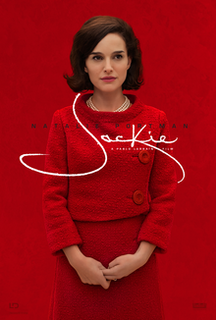
Jackie is a 2016 biographical drama film directed by Pablo Larraín and written by Noah Oppenheim. The film stars Natalie Portman as Jackie Kennedy and tells the story of her life immediately after the 1963 assassination of her husband John F. Kennedy. Peter Sarsgaard, Greta Gerwig, Billy Crudup, and John Hurt also star; it was Hurt's final film released before his death in January 2017.

Marie-Hélène Françoise Arnaud was a French model and actress. Working as a house model for the French fashion house Chanel, she was the "face of Chanel" in the 1950s; she also developed a second career as an actress.
